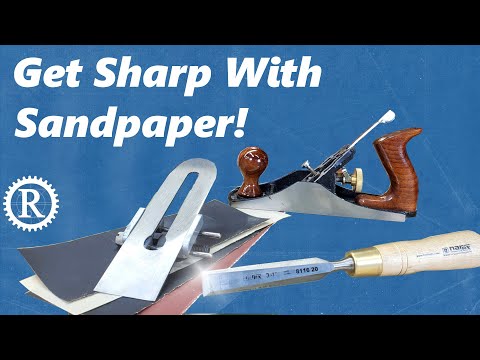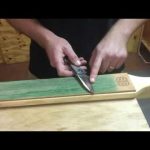
59e8ea6193d9e059779da8f4de8c2dfe
Sharpening tools is an essential part of any woodworking or metalworking project. It is important to have a sharp edge on your tools in order to get the best results. Sandpaper is a great way to sharpen tools, and it is relatively easy to do. This guide will provide you with the information you need to know in order to achieve a perfect edge when sharpening with sandpaper. We will discuss the different types of sandpaper, the best techniques for sharpening, and the safety precautions you should take when using sandpaper. With this guide, you will be able to sharpen your tools with confidence and achieve the perfect edge every time.
Can you sharpen a blade with sandpaper
Sharpening a blade is an important part of maintaining a knife, axe, or other cutting tool. While there are many methods for sharpening a blade, one of the most common is using sandpaper. Sandpaper is an effective way to sharpen a blade, but it is important to understand the process and use the right type of sandpaper.
Types of Sandpaper
Sandpaper comes in a variety of grits, from very coarse to very fine. Coarse sandpaper is best for removing large amounts of material from a blade, while finer grits are better for polishing and honing the edge. It is important to use the right type of sandpaper for the job, as using the wrong grit can damage the blade.
Sharpening with Sandpaper
When sharpening a blade with sandpaper, it is important to use a flat surface. A piece of glass or a granite countertop works well. Place the sandpaper on the flat surface and hold the blade at a low angle. Move the blade back and forth across the sandpaper, applying light pressure. Be sure to keep the blade at the same angle throughout the process.
Once the blade is sharpened, it is important to finish the process by honing the edge. This can be done by using a finer grit sandpaper or a honing stone. This will help to remove any burrs and create a smooth, sharp edge.
Conclusion
Sharpening a blade with sandpaper is an effective way to maintain a cutting tool. It is important to use the right type of sandpaper and to keep the blade at a consistent angle throughout the process. After sharpening, it is important to finish the process by honing the edge with a finer grit sandpaper or a honing stone.
Can you sharpen a plane with sandpaper
Sharpening a plane is an important part of woodworking. A sharp plane will make smoother cuts and help you achieve a better finish. But can you sharpen a plane with sandpaper?
The answer is yes, you can sharpen a plane with sandpaper. Sandpaper is a great way to sharpen a plane because it is inexpensive and easy to use. You can use any type of sandpaper, from coarse to fine, depending on the type of plane you are sharpening.
To sharpen a plane with sandpaper, start by laying the sandpaper on a flat surface. Place the plane blade on the sandpaper and move it back and forth in a circular motion. Make sure to keep the blade flat against the sandpaper and move it in a consistent motion. You can also use a honing guide to help keep the blade at the correct angle.
Once you have sharpened the blade, you can use a honing stone to further refine the edge. This will help to remove any burrs or imperfections that may have been left behind by the sandpaper.
Sharpening a plane with sandpaper is a great way to get a sharp edge without spending a lot of money.
It is also a great way to learn the basics of sharpening a plane. With a little practice, you can get a sharp edge that will last for a long time.
What grit sandpaper to sharpen
Sharpening tools is an important part of any woodworking project. The right sandpaper can make a huge difference in the quality of the finished product. But what grit sandpaper should you use to sharpen your tools?
The answer depends on the type of tool you are sharpening. For most woodworking tools, a medium-grit sandpaper is the best choice. A grit of around 120-150 is usually ideal for sharpening tools. This grit is coarse enough to remove material quickly, but not so coarse that it damages the tool.
If you are sharpening a very dull tool, you may need to start with a coarser grit. A grit of 80-100 is usually a good choice for very dull tools. This grit will remove material quickly, but it may leave a rougher finish than a finer grit.
Once you have sharpened the tool with a coarse grit, you can switch to a finer grit to refine the edge. A grit of 220-320 is usually a good choice for refining the edge. This grit will remove any remaining burrs and leave a smooth, sharp edge.
No matter what grit sandpaper you use, it is important to use a light touch when sharpening. Too much pressure can damage the tool and leave a rough finish. It is also important to use a sanding block or sanding pad to ensure that the sandpaper is flat against the tool.
In conclusion, the best grit sandpaper to sharpen your tools depends on the type of tool and the condition of the edge. For most woodworking tools, a medium-grit sandpaper of 120-150 is usually ideal. For very dull tools, a coarser grit of 80-100 may be necessary. Once the edge is sharpened, a finer grit of 220-320 can be used to refine the edge.
Can you sharpen wood with sandpaper
Sandpaper is a great tool for smoothing and shaping wood, but can it be used to sharpen wood? The answer is yes, but it is important to understand the limitations of sandpaper and how to use it properly.
Sandpaper is made up of abrasive particles that are designed to remove material from the surface of the wood. This makes it ideal for smoothing and shaping wood, but it is not as effective at sharpening wood as other tools such as chisels and planes. Sandpaper can be used to sharpen wood, but it is best used for small, delicate tasks such as sharpening the edges of a carving or the tip of a dowel.
When using sandpaper to sharpen wood, it is important to use the correct grit. Coarse grits are best for removing material quickly, while finer grits are better for polishing and finishing. It is also important to use the sandpaper correctly. Start with a coarse grit and work your way up to a finer grit, using light, even strokes. This will help to ensure that the wood is sharpened evenly and without damaging the surface.
Sandpaper can be a useful tool for sharpening wood, but it is important to understand its limitations. It is best used for small, delicate tasks and should not be used for larger projects. It is also important to use the correct grit and to use light, even strokes when sharpening with sandpaper.
We hope this guide has been helpful in teaching you how to sharpen with sandpaper. With practice and patience, you’ll be able to achieve a perfect edge every time. Thank you for reading and goodbye!














